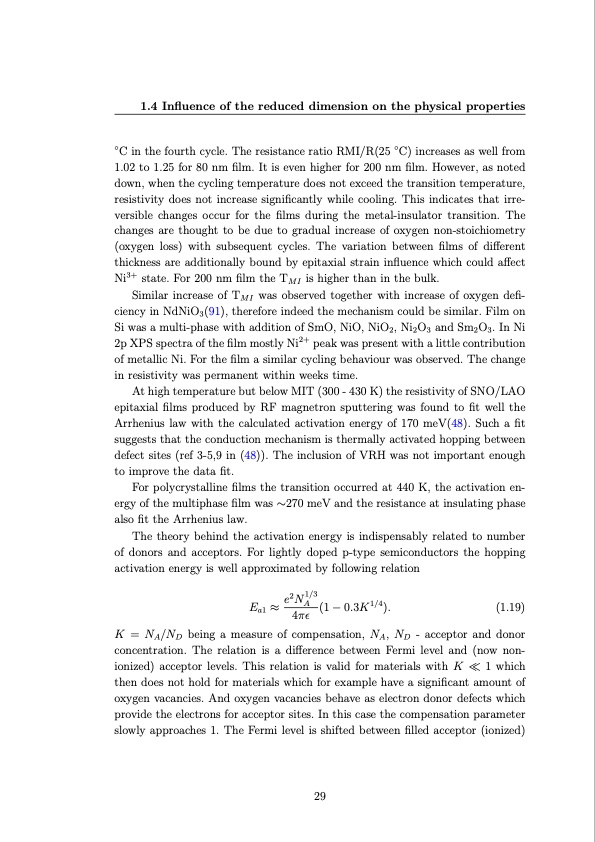
PDF Publication Title:
Text from PDF Page: 050
1.4 Influence of the reduced dimension on the physical properties ◦C in the fourth cycle. The resistance ratio RMI/R(25 ◦C) increases as well from 1.02 to 1.25 for 80 nm film. It is even higher for 200 nm film. However, as noted down, when the cycling temperature does not exceed the transition temperature, resistivity does not increase significantly while cooling. This indicates that irre- versible changes occur for the films during the metal-insulator transition. The changes are thought to be due to gradual increase of oxygen non-stoichiometry (oxygen loss) with subsequent cycles. The variation between films of different thickness are additionally bound by epitaxial strain influence which could affect Ni3+ state. For 200 nm film the TMI is higher than in the bulk. Similar increase of TMI was observed together with increase of oxygen defi- ciency in NdNiO3(91), therefore indeed the mechanism could be similar. Film on Si was a multi-phase with addition of SmO, NiO, NiO2, Ni2O3 and Sm2O3. In Ni 2p XPS spectra of the film mostly Ni2+ peak was present with a little contribution of metallic Ni. For the film a similar cycling behaviour was observed. The change in resistivity was permanent within weeks time. At high temperature but below MIT (300 - 430 K) the resistivity of SNO/LAO epitaxial films produced by RF magnetron sputtering was found to fit well the Arrhenius law with the calculated activation energy of 170 meV(48). Such a fit suggests that the conduction mechanism is thermally activated hopping between defect sites (ref 3-5,9 in (48)). The inclusion of VRH was not important enough to improve the data fit. For polycrystalline films the transition occurred at 440 K, the activation en- ergy of the multiphase film was ∼270 meV and the resistance at insulating phase also fit the Arrhenius law. The theory behind the activation energy is indispensably related to number of donors and acceptors. For lightly doped p-type semiconductors the hopping activation energy is well approximated by following relation e2N1/3 Ea1 ≈ A (1 − 0.3K1/4). (1.19) 4πε K = NA/ND being a measure of compensation, NA, ND - acceptor and donor concentration. The relation is a difference between Fermi level and (now non- ionized) acceptor levels. This relation is valid for materials with K ≪ 1 which then does not hold for materials which for example have a significant amount of oxygen vacancies. And oxygen vacancies behave as electron donor defects which provide the electrons for acceptor sites. In this case the compensation parameter slowly approaches 1. The Fermi level is shifted between filled acceptor (ionized) 29PDF Image | Investigation of metal-insulator transition in magnetron sputtered samarium nickelate thin films

PDF Search Title:
Investigation of metal-insulator transition in magnetron sputtered samarium nickelate thin filmsOriginal File Name Searched:
Bilewska_Investigation_of_metal_insulator_transition_in_magnetron_sputtered_samarium.pdfDIY PDF Search: Google It | Yahoo | Bing
Sulfur Deposition on Carbon Nanofibers using Supercritical CO2 Sulfur Deposition on Carbon Nanofibers using Supercritical CO2. Gamma sulfur also known as mother of pearl sulfur and nacreous sulfur... More Info
CO2 Organic Rankine Cycle Experimenter Platform The supercritical CO2 phase change system is both a heat pump and organic rankine cycle which can be used for those purposes and as a supercritical extractor for advanced subcritical and supercritical extraction technology. Uses include producing nanoparticles, precious metal CO2 extraction, lithium battery recycling, and other applications... More Info
| CONTACT TEL: 608-238-6001 Email: greg@infinityturbine.com | RSS | AMP |